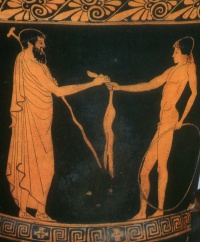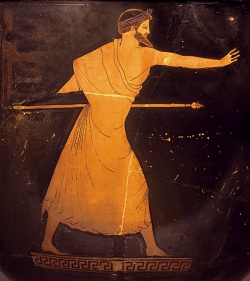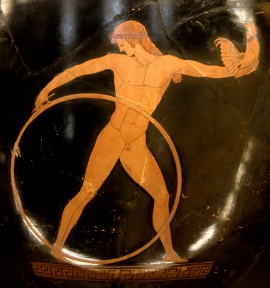Hoop rolling (ancient Greece): Difference between revisions
No edit summary |
No edit summary |
||
| Line 1: | Line 1: | ||
[[Image:AEGISTHOS PAINTER -460c Love gift (Kunsthistorisches Museum Wien IV-1102) 852x1030.jpg|thumb|200px|left|'''Love gift'''<br>Man presents a leg of mutton to a youth with a hoop, in an allusion to boylove.<ref>''Antike Welten: Meisterwerke griechischer Malerei as dem Kunsthistorischen Museum Wien'', 1997, pp.110-111</ref> Athenian red-figure vase, ca. 460 BC]] | [[Image:AEGISTHOS PAINTER -460c Love gift (Kunsthistorisches Museum Wien IV-1102) 852x1030.jpg|thumb|200px|left|'''Love gift'''<br>Man presents a leg of mutton to a youth with a hoop, in an allusion to boylove.<ref>''Antike Welten: Meisterwerke griechischer Malerei as dem Kunsthistorischen Museum Wien'', 1997, pp.110-111</ref> Athenian red-figure vase, ca. 460 BC]] | ||
The hoop held symbolic meanings in Greek myth and culture and was used to represent a boy or youth in general in Greek art. The Greeks referred to the hoop as the ''trochus'' or ''krikoi,'' and they were probably made of bronze, iron, or copper. They were driven with a stick called the ''elater''.<ref>Athletics and Games of the Ancient Greeks By Edward M Plummer; p50</ref> | The hoop held symbolic meanings in Greek myth and culture and was used to represent a boy or youth in general in Greek art. The Greeks referred to the hoop as the ''trochus'' or ''krikoi,'' and they were probably made of bronze, iron, or copper. They were driven with a stick called the ''elater''.<ref>Athletics and Games of the Ancient Greeks By Edward M Plummer; p50</ref> The boys would roll them down the street running along side or have races. | ||
Images of the hoop are often presented in the context of boylove in ancient Greece.<ref>The ancient Olympics By Nigel Jonathan Spivey; p48</ref> A spear, trident or wooden staff is sometimes depicted penetrating the boy's hoop as a symbolic allusion to the sexual nature of the relationship.<ref>http://www.homoerotimuseum.net/eur/eur07/329.html</ref> | A bronze hoop was one of the toys of the infant [[Dionysus]],<ref>Forerunners and Rivals of Christianity: Being Studies in Religious History from 330 B.C. to 330 A.D. by Francis Legge; 1915 p. 125</ref> and hoop driving is an attribute of [[Ganymede (mythology)|Ganymede]], often depicted on [[Ancient Greece|Greek]] vase paintings from the 5th century BC. It was a very popular toy among ancient Greek kids and the sport was regarded as healthful, and was recommended by [[Hippocrates]] for strengthening weak constitutions.<ref>"Hippocrates recommended playing with a hoop as a cure for weak people" Psychoanalytic perspectives on art: PPA, Volume 1 - Page 97 by Mary Mathews Gedo</ref> Though there are no images or written accounts, one can imagine that some rambunctious young Greek boy likely invented the ''Hula hoop'' 3000 years before Wham-O. | ||
Images of the hoop are often presented in the context of boylove in ancient Greece.<ref>The ancient Olympics By Nigel Jonathan Spivey; p48</ref> A trochus/hoop was a favorite gift given by a Greek man to the boy he fancied. <ref> http://www.scribd.com/doc/153553844/Sexuality-in-Greek-and-Roman-Culture</ref> A spear, trident or wooden staff is sometimes depicted (on pottery) penetrating the boy's hoop as a symbolic allusion to the sexual nature of the relationship.<ref>http://www.homoerotimuseum.net/eur/eur07/329.html</ref> | |||
Revision as of 12:39, 27 September 2013

Man presents a leg of mutton to a youth with a hoop, in an allusion to boylove.[1] Athenian red-figure vase, ca. 460 BC
The hoop held symbolic meanings in Greek myth and culture and was used to represent a boy or youth in general in Greek art. The Greeks referred to the hoop as the trochus or krikoi, and they were probably made of bronze, iron, or copper. They were driven with a stick called the elater.[2] The boys would roll them down the street running along side or have races.
A bronze hoop was one of the toys of the infant Dionysus,[3] and hoop driving is an attribute of Ganymede, often depicted on Greek vase paintings from the 5th century BC. It was a very popular toy among ancient Greek kids and the sport was regarded as healthful, and was recommended by Hippocrates for strengthening weak constitutions.[4] Though there are no images or written accounts, one can imagine that some rambunctious young Greek boy likely invented the Hula hoop 3000 years before Wham-O.
Images of the hoop are often presented in the context of boylove in ancient Greece.[5] A trochus/hoop was a favorite gift given by a Greek man to the boy he fancied. [6] A spear, trident or wooden staff is sometimes depicted (on pottery) penetrating the boy's hoop as a symbolic allusion to the sexual nature of the relationship.[7]
Zeus and Ganymede
The imiges below are from a red-figure bell Krater depicting Ganymede and Zeus attributed to the Berlin Painter circa 500-480 BC. Kraters were used at banquets for mixing wine and water.[8] Zeus pursues the boy Ganymedes, who is playings with a toy hoop, symbol of his youth, and a cock, a traditional gift given to boys by their male suitors.
  |
References
- ↑ Antike Welten: Meisterwerke griechischer Malerei as dem Kunsthistorischen Museum Wien, 1997, pp.110-111
- ↑ Athletics and Games of the Ancient Greeks By Edward M Plummer; p50
- ↑ Forerunners and Rivals of Christianity: Being Studies in Religious History from 330 B.C. to 330 A.D. by Francis Legge; 1915 p. 125
- ↑ "Hippocrates recommended playing with a hoop as a cure for weak people" Psychoanalytic perspectives on art: PPA, Volume 1 - Page 97 by Mary Mathews Gedo
- ↑ The ancient Olympics By Nigel Jonathan Spivey; p48
- ↑ http://www.scribd.com/doc/153553844/Sexuality-in-Greek-and-Roman-Culture
- ↑ http://www.homoerotimuseum.net/eur/eur07/329.html
- ↑ http://www.mam.gov.mo/photodetail.asp?productkey=2008041201094&lc=3